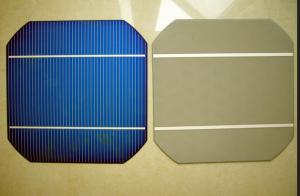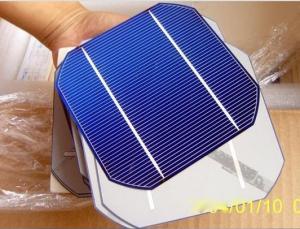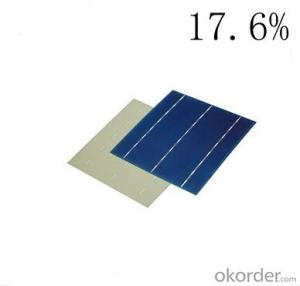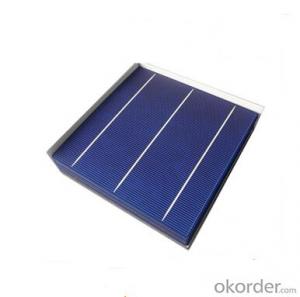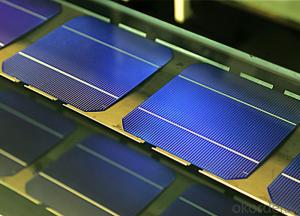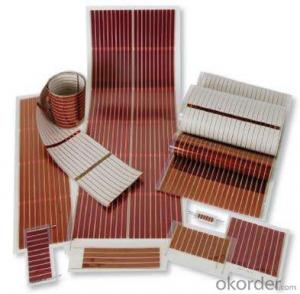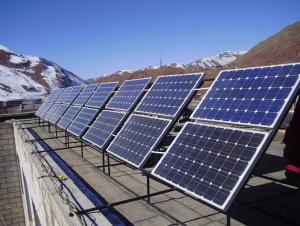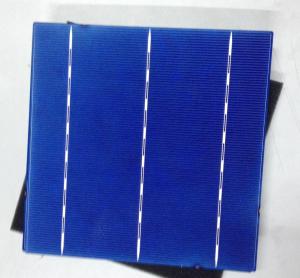Next Generation Solar Cells:Low Price, High Quality UV-Resistant Silicon
- Loading Port:
- Shanghai
- Payment Terms:
- TT or LC
- Min Order Qty:
- 500 pc
- Supply Capability:
- 20000 pc/month
OKorder Service Pledge
OKorder Financial Service
You Might Also Like
| Specifications | |||||
| Size: | 156*156±0.5mm | Max. Power: | 3.99w | Product: | damaged solar cells |
| Pmp: | 3.99w | Vmp: | 0.516v | Imp: | 7.731A |
| Voc: | 0.621v | Isc: | 8.262A | Efficiency: | 16.25-16.50% |
| Thickness: | 190±20um | Format: | 156*156±0.5mm | FF: | 77.77% |
Packaging & Delivery
| Packaging Detail: | Original Package, 100pcs in one boxes, 10boxes in one carton |
| Delivery Detail: | 1~2days |
damaged solar cells
solar cells in stock with immediate delivery with big quantity, all range cells avaiable
Manufacturer
1,Components,ultra-white Executed tempered glass+PVB+cell+PVB+tempered glass
Glass+PVB+Cell+PVB+Glass
2,Components with ultra-white Executed tempered glass+PVB+cell+PVB+tempered glass+of PVB+tempered glass
Glass+PVB+Cell+PVB+Glass+PVB+Glass
Quality and Safety
1.Rigorous quality control meeting the highest international standards
2.High-transmissivity low-iron tempered glass, strong aluminium frame
3.Using UV-resistant silicon
4.ISO 9001:2008 and ISO 14001:2004
5.IEC61215, IEC61730, Safety Class in conformity to CE
Features
1.High conversion efficiencies resulting in superior power output performance.
2.Outstanding power output even in low light or high temperature conditions
3.Optimized design for ease of soldering and lamination
4.Long-term stability,reliability and performance
Warranties
1.10 years limited product warranty
2.15 years at 90% of the minimal rated power output
3.25 years at 80% of the minimal rated power output
Format: 156mm x 156mm
Thickness: 190um+-20um
Front(-): 1.7mm bus bars(silver),blue anti-reflecting coating(silicon nirtride)
back(+): 3mm wide soldering pads(silver) back surface field(aluminium)
| Size | 156mm x156mm ±0.5mm | |||||
| Thickness | 190um ± 20um | |||||
| Front surface(-) | 1.7mm bus bars(silver), blue anti-reflecting coating(Silicon nitride) | |||||
| Back surface (+) | 3mm wide soldering pads(silver) back surface field(Aluminum) | |||||
| TkVoltage | -0.351%/K | |||||
| TkCurrent | +0.035%/K | |||||
| TkPower | -0.47%/K | |||||
| Efficiency(%) | Pmp(W) | Vmp(V) | Imp(A) | Voc(V) | Isc(A) | FF(%) |
| 16.25-16.50 | 3.99 | 0.516 | 7.731 | 0.621 | 8.262 | 77.77 |
| 16.00-16.25 | 3.92 | 0.512 | 7.66 | 0.616 | 8.195 | 77.68 |
| 15.75-16.00 | 3.86 | 0.509 | 7.584 | 0.613 | 8.135 | 77.43 |
| 15.50-15.75 | 3.8 | 0.505 | 7.525 | 0.611 | 8.08 | 77.04 |
| 15.25-15.50 | 3.74 | 0.502 | 7.458 | 0.609 | 8.053 | 76.2 |
| 15.00-15.25 | 3.68 | 0.5 | 7.365 | 0.609 | 8.038 | 75.12 |
| 14.75-15.00 | 3.62 | 0.498 | 7.271 | 0.607 | 8.045 | 74.23 |
| 14.50-14.75 | 3.56 | 0.497 | 7.16 | 0.604 | 8.04 | 73.3 |
| 14.25-14.50 | 3.5 | 0.494 | 7.091 | 0.603 | 8.08 | 71.84 |
| 14.00-14.25 | 3.44 | 0.494 | 6.96 | 0.601 | 8.065 | 70.91 |
solar cell Pic. and drawing:
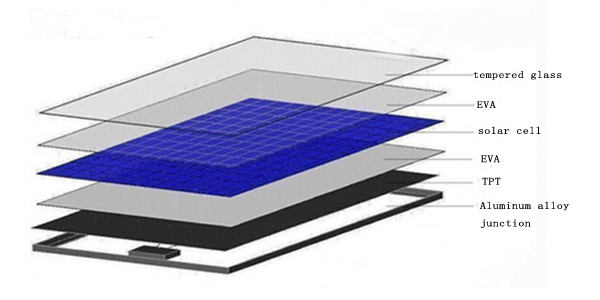
FAQ
1, What’s price per product ?
A: It’s depends on the quantity, delivery date and payment terms of the order. We can talk further about the detail price issue. Our products is high quality with lower price level.
2, How to make payment?
We accept T/T or L/C.
3, What is your lead time?
Generally 1-5 weeks depends on the order quantity and your specific requirements.
4, Can you do OEM for us?
Yes, we can.
5, How do you pack your products?
We have rich experience on how to pack the panels to make sure the safety on shipment when it arrives at the destination.
Cheap and efficient, solar cell industry to increase its share in the energy mix, it must simultaneously satisfy these two conditions and the answer is the new material.
Perovskite solar cells is one of the most promising of several photovoltaic technology, the theoretical conversion efficiency up to 50%, twice the current market solar cell conversion efficiency, can significantly reduce the cost of solar cells. Although the perovskite material is relatively cheap, but with its manufacture of solar cells also need to use an organic hole conducting polymer called spiro-OMeTAD, its market price is 10 times more than gold.
Perovskite is a class of materials having a specific crystal structure of the solar cell manufacturing is concerned, this structure has a natural advantage: high charge carrier mobility and good light diffusion properties, the photoelectric energy conversion process low losses. Although copper iodide can act as a perovskite solar cells hole conductor it is now only being proved, but it is thought to act as an important role in dye-sensitized solar cell and a quantum dot solar cells before the copper conductor, and the most attractive force is their excellent electrical conductivity. Conductivity of copper iodide conductor spiro-OMeTAD than two orders of magnitude, which enable them to achieve higher fill factor also determines a greater use of its power system into a solar cell with low price. But the current findings suggest that contain copper iodide perovskite solar cell conversion efficiency is temporarily less on the original technology. The researchers believe this may be related to a lower voltage related. This future is expected by lowering its high recombination rate to compensate.
The researchers found that copper iodide solar cells with low price also exhibit an advantage is its excellent stability. The results showed that after two hours of continuous light, copper iodide solar cells did not reduce the current, and the current spiro-OMeTAD solar cell produced decreased by 10%. This is crucial for a solar cell made. Chris said the next step they will optimize experimental procedures, so as to achieve higher conversion efficiency.
- Q: Can solar cells be used in powering electric boats?
- Yes, solar cells can be used to power electric boats. Solar panels can be installed on the boat's surface to capture sunlight and convert it into electricity, which can then be used to power the boat's electric motor and other electrical systems. This enables the boat to operate without relying on traditional fuel sources, making it a more environmentally friendly and sustainable option.
- Q: Can solar cells be used for electric vehicle charging?
- Yes, solar cells can be used for electric vehicle charging. Solar panels can convert sunlight into electricity, which can then be used to charge the batteries of electric vehicles. This allows for a sustainable and renewable source of energy for electric vehicle charging.
- Q: What is the role of fuses in solar cell systems?
- The role of fuses in solar cell systems is to protect the system from possible overcurrent or short circuit conditions. Fuses act as safety devices that interrupt the electrical circuit when the current exceeds a certain threshold, preventing damage to the solar cells, wiring, and other components.
- Q: Can solar cells be used for cooking?
- Yes, solar cells can be used for cooking. Solar cookers are designed to capture and convert sunlight into heat energy, which can then be used for cooking food. These cookers utilize solar cells to generate electricity, which can power electric stoves or ovens for cooking. Additionally, some solar cookers directly convert sunlight into heat using reflective surfaces and insulation, eliminating the need for electricity altogether.
- Q: What are the advantages of monocrystalline silicon and polycrystalline silicon in solar power?
- polysilicon, ribbon silicon, thin film materials (including microcrystalline silicon-based film, compound-based film and dye film). From the industrial development point of view, the focus from the single crystal to the direction of the development of polysilicon and film, the main reason: [1] solar head can supply more and less head and tail; [2] for solar cells, (3 hours) The production process of polysilicon is progressing continuously. The automatic casting furnace can produce more than 200 kilograms of ingot per production cycle (50 hours),
- Q: Can solar cells be used to charge electric vehicles?
- Yes, solar cells can be used to charge electric vehicles. Solar panels can convert sunlight into electricity, which can then be used to charge the batteries of electric vehicles. This process, known as solar charging or solar-powered charging, is an environmentally friendly and sustainable way to power electric vehicles.
- Q: How do solar cells perform in regions with high levels of snowfall and blizzards?
- Solar cells generally do not perform optimally in regions with high levels of snowfall and blizzards. The snow accumulation on the solar panels can significantly reduce their ability to generate electricity as it blocks the sunlight from reaching the cells. However, advancements in technology and design have led to the development of snow-resistant solar panels that can shed snow more easily and continue to generate electricity even in snowy conditions. Additionally, the angle and tilt of the panels can also play a role in snow shedding. Overall, while solar cells may not perform at their highest efficiency in regions with heavy snow, it is still possible to generate some electricity with proper installation and maintenance practices.
- Q: Can solar cells be used in swimming pool heating?
- Yes, solar cells can be used in swimming pool heating. Solar panels can capture sunlight and convert it into energy, which can then be used to heat the pool water. This renewable energy source is environmentally friendly and can help reduce energy costs associated with pool heating.
- Q: Can solar cells be used in theme parks?
- Yes, solar cells can be used in theme parks. Solar cells can be installed on rooftops, parking lots, or open spaces within theme parks to generate clean and renewable energy. This energy can be used to power rides, lighting, and other facilities, reducing the park's dependence on traditional energy sources and lowering its carbon footprint. Additionally, solar cells can also serve as educational tools, allowing visitors to learn about renewable energy and sustainability.
- Q: How do solar cells handle snow or ice accumulation?
- Solar cells are designed to be durable and able to withstand snow or ice accumulation. However, when covered by snow or ice, their energy production is significantly reduced. Some solar panels are designed with a tilted angle and smooth surface, allowing snow to slide off easily. Additionally, the dark color of solar cells helps them absorb sunlight and melt the snow or ice faster. In extreme cases, manual removal of snow or ice may be necessary to restore optimal energy generation.
Send your message to us
Next Generation Solar Cells:Low Price, High Quality UV-Resistant Silicon
- Loading Port:
- Shanghai
- Payment Terms:
- TT or LC
- Min Order Qty:
- 500 pc
- Supply Capability:
- 20000 pc/month
OKorder Service Pledge
OKorder Financial Service
Similar products
Hot products
Hot Searches
Related keywords















